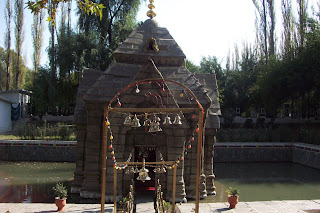Pandrethan Shiva Temple, Jammu and Kashmir

Address
Pandrethan Shiva Temple, Badami Bagh Cantonment, Srinagar, Jammu and Kashmir 191101
Diety
Shiva
Introduction
The small village of Pandrethan is situated 3 miles above Srinagar on the Anantnag cart-road. Pandrethan is an ancient stone temple dedicated to Lord Shiva that lies within a square shaped tank to the north of Jhelum River. It is located about four miles from Srinagar city. This temple is also known as Meru Vardhana Swami. The roof of the temple was carved out of a single piece of rock and known for its impressive designs. The domed roof and arches of the temple are the best examples of classic Kashmiri architecture.
Puranic Significance
It was originally an old capital of Kashmir and is believed to have been founded by King Pravarasena, sometime in the 6th century CE. The word ‘Pandrethan’ is derived from ‘Puranadishthana’ or ‘old town. It is now a military cantonment, but is known for its small but exquisite Shiva temple, also known as the Meruvardhanaswami temple The Pandrethan temple was built by Meru, a minister of King Partha, who ruled Kashmir from 921-931 CE. The temple is dedicated to Lord Shiva and is situated around 100 yards from the banks of river Jhelum. The city of Pandrethan was said to have been destroyed in a great fire around 960 CE. The only structure that is said to have survived is this temple. The temple stands in the centre of a tank of water… The stone ceiling is elaborately carved in bas-relief figures, and it is one of the most perfect pieces of ancient carving that exists in Kashmir…The pyramidal roof is divided into two portions by an ornamental band. The corner pilasters are surmounted by carved capitals, and the pediments of the porches appear to have terminated with a melon-shaped ornament. The ceiling is formed of nine blocks of stone; four resting over the angles of the cornice, reduce the opening to a square, and an upper course of four stones still further reduces the opening, which is covered by a single block decorated with a large lotus.’
Century/Period/Age
6th century CE.
Managed By
Archaeological Survey of India (ASI)
Nearest Bus Station
Srinagar
Nearest Railway Station
Srinagar Station
Nearest Airport
Jammu




